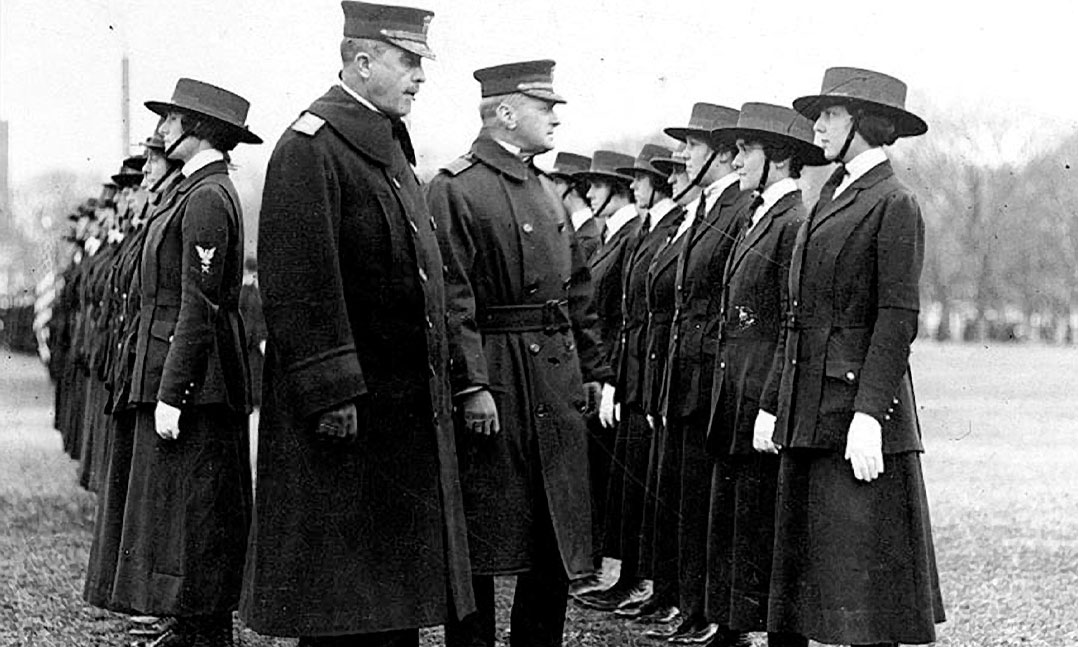One of the requisite World War I recruitment posters showed a beautiful and composed nurse bending over a young soldier gazing up at her in gratitude and admiration.
Such art was, of course, a fantasy, and by war’s end it was an affront to truth. Thousands of U.S. nurses served admirably during the Great War of 1914-18, but there was nothing romantic about their experience. Trench warfare and the impact of the machine gun on infantry operations created an avalanche of casualties that turned field hospitals into hospices of horror.
During the Battle of Belleau Wood in June 1918, for instance, "hundreds and hundreds of wounded poured in like a rushing torrent,” Army Nurse Eula Crow wrote in her diary. "The packed, twisted bodies, the screams and groans, made me think of Dante’s Inferno.”

Conditions were even worse in the forest west of Chemin des Dames, some 80 miles northeast of Paris, where three major WWI battles took place. Resupplying the nurses there was a major challenge.
In every field hospital, evacuation station or clearinghouse (such as churches turned into hospitals), American nurses faithfully discharged their duties as they dealt with the stench of gangrene, the heart-wrenching shell-shock cases and shelling from enemy lines.
In the second half of the Great War’s final year, these nurses had to deal with a new scourge. Hundreds of fevered soldiers and Marines — and the nurses who cared for them — succumbed to Spanish influenza. The disease would spread around the world and in 11 months kill more people than the war itself.
‘YEOMENETTES’ JOIN THE NAVY
More than 22,000 American nurses were recruited by the Red Cross to serve in the U.S. Army between 1917-1919, according to the PBS article "American Nurses in World War I,” and more than 10,000 served near the Western Front. Another 1,500 served in the U.S. Navy, several hundred worked for the Red Cross and some worked in U.S. units attached to the British and French armies.
Women served with the U.S. military in other roles, too.
The Naval Act of 1916 declared that the Navy’s reserve force would consist of "all persons who may be capable of performing special useful service for coastal defense.” This "unassuming” language "unintentionally” opened the door to women enlisting in the Navy, according to Prologue magazine, the official publication of the U.S. National Archives.
And enlist they did — as yeomen (clerks), electricians, radio operators, nurses or any other ratings necessary to naval coastal defense. Most became yeomen, and each was designated as "yeoman (F) for a female yeoman,” according to Prologue. It was the first category of military service in which women could enlist and serve with equal rank, pay and promotion potential as male servicemen. A woman with an (F) rating became best known as a "yeomanette.”
Yeomenettes demonstrated not only that women were capable of duties supporting active military troops, but also that their own enlistment in the military was invaluable in multiple capacities, not the least of which was "freeing sailors for the fleet.” Many yeomenettes performed administrative duties, but others worked as "mechanics, truck drivers, telephone operators, cryptographers and munitions makers,” according to Prologue.
Barred from sea duty, yeomenettes suffered casualties nonetheless, although all were non-hostile. Differing sources peg a total of between 22 and 57 who died in service, with causes of death ranging from Spanish influenza to accidents.
One such accident, according to Prologue, took the life of Yeoman (F) Mary Agnes Monahan, who had enlisted in the Naval Reserve on March 12, 1918, in Boston. Her assigned duty station was at the Boston Navy Yard, where she worked as a truck driver. She was killed in a car wreck in Hampton Falls, N.H., on Sept. 10, 1918.
NURSES DIED FROM HOSTILE FIRE
On the other side of the pond, the 120 casualties suffered by American women were often combat related. Marion G. Crandell, for instance, a YMCA canteen worker, was killed along with a soldier on March 27, 1918, by enemy fire in Ste. Menehould, France, according to the U.S. WWI Centennial Commission website (www.worldwar1centennial.org).
Two days later, Ruth Landon, a Red Cross worker from New York and a great-niece of Vice President Levi P. Morton, was killed by a German shell on March 29, 1918, while tending to an injured soldier.
The courageous actions of America’s female nurses did not go unnoticed by Pershing and his officer corps. Army nurse Glorietta Trivett, for example, who helped pull wounded soldiers out of the trenches, was one of 200 nurses cited for bravery under fire.
The Great War of 1914-18 was a war for democracy and liberty. The yeomenettes who served selflessly stateside, and the nurses who faithfully discharged their duties near the front lines, demonstrated what a woman’s place in modern society would be. They proved they could tend to wounded troops in a high-stress workplace that included the threat of attack from enemy combatants.
Their efforts and contributions also left a lasting legacy that inspired change across the nation. Their service helped propel the passage of the U.S. Constitution’s 19th Amendment on June 4, 1919, guaranteeing women the right to vote. The Great War’s great women deserve praise and admiration.
This article is featured in the November/December 2018 issue of VFW magazine, and was written by B. Gordon Wheeler, a freelance writer based in Chino, Calif. Photo courtesy of the U.S. Navy.
